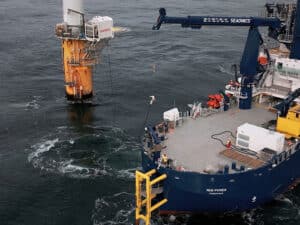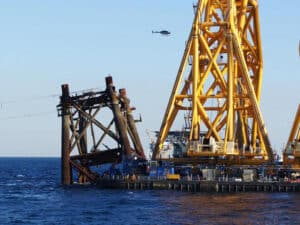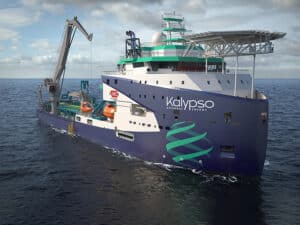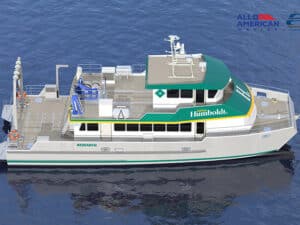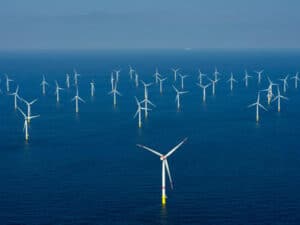
Offshore wind vessel ordering gathers momentum
Written by Nick Blenkey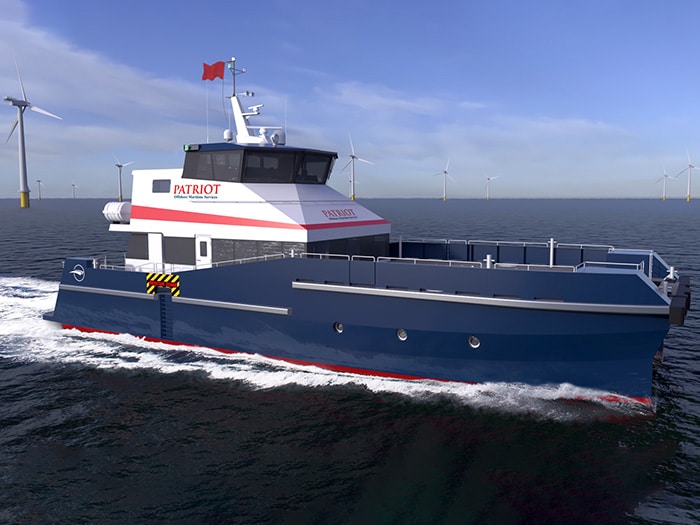
The Scania quad V8 powered 27-meter CTV will be based on a proven catamaran design by Incat Crowther.
Offshore wind vessel developments are picking up pace worldwide, generating a wide range of new designs for everything from massive wind turbine installation vessels (WTIVs) through to the crew transfer vessels that are the pick-up trucks of the industry. In the U.S., orders are starting to turn from a spotty dribble to a steady trickle, though there is as of yet just one solitary WTIV under construction — the $500 million Charybdis under construction at Keppel AmFELS for Dominion Energy.
The high price of building a world class WTIV like the GustoMSC NG-16000X-SJ design Charybdis has prompted a lot of thinking on Jones Act compliant workarounds. The most selected alternative thus far has been to use foreign-flag, foreign-built WTIVs and to feeder them with turbine components using Jones Act tugs and barges. The problem for wind farm developers in this, of course, is that the global fleet of WTIVs is limited and U.S. developers will have to compete for them.
One alternative is to use a less complex WTIV if the vessel is only going to do installation work and not transport turbine components. Houston-headquartered Bleutec Industries Offshore Wind Services LLC believes it has the answer in its Binary Marine Installation Solution (BMIS).
Bleutec’s BMIS is a spread of vessels designed to operate simultaneously or independently in offshore wind developments. It comprises a pile installation vessel (PIV) and a wind turbine installation vessel light (WTIVL), and service operations vessels (SOVs), all specifically tailored for the U.S. Jones Act market.
The vessels are designed in a modular configuration to facilitate their construction in U.S. shipyards. The piling installation vessel will feature a gantry crane capable of lifting up to 4,500 tonnes, a hydraulic hammer, and deck space for the piles. The WTIV light will be capable of installing wind turbines of up to 22 MW, while the SOVs will provide the necessary accommodations and crew support services for working in depths of up to 60 meters.
All the Bleutec vessels are designed to be powered by Wärtsilä dual-fuel engines paired with Wärtsilä’s hybrid battery energy storage systems and will incorporate the latest advances in dynamic positioning.
So, what’s the price tag? According to MARAD’s most recent (February 23) listing of pending Title XI financing applications, Bleutec has filed an application for Title Xi guarantees for construction of four vessels, the piling vessel, the WTIVL and two SOVs. The MARAD listing doesn’t show how much is requested for each vessel but lists the actual cost to the applicant for all four as $809,709,000. The builder is listed as “to be determined.”
There are now three SOVs on order in the U.S., in addition to the two already under construction for Edison Chouest Offshore (ECO). Regarding price tags, according to the MARAD Title XI applications, the first of the ECO pair, which will be built at Tampa Ship will have an actual cost to the applicant of $97,150,000. The second, a plug-in hybrid which will be built at LaShip, will come in at an actual cost of $108,750,000.
The third U.S.-built SOV has been ordered by the CREST Wind joint venture between Crowley and Esbjerg, Denmark-headquartered Esvagt to operate under a long-term charter with Siemens Gamesa Renewable Energy. It will be built at Fincantieri Marine Group’s Fincantieri Bay Shipbuilding (FBS) in Sturgeon Bay, Wis., with support from Crowley’s on-site construction management group, and is set to go into service in 2026.
The 289-foot vessel will feature state-of-the-art technologies to augment safety, workability, and comfort to support wind farm O&M activities. The SOV is designed for comfort and high workability, providing a highly efficient workspace and safe transfer of technicians at the wind farm via a motion-compensated gangway and transfer boats. It will also offer recreational activities for the onboard crew and technicians, including fitness facilities, a game room, a cinema, and individual accommodations.
The SOV’s HAV 832 design has been developed by Norway’s Hav Design, a subsidiary of HAV Group ASA.
“We have designed and developed numerous SOVs for use in demanding offshore climates, but this is the first time we are designing a vessel for the U.S. market. We are confident in the operational benefits our vessel design brings to the table, so we believe that this contract can open the door for further work in the USA,” said Gisle Vinjevoll Thrane, vice president of sales at HAV Design.
CTV ORDER PIPELINE DEVELOPS
Meantime, U.S. orders for crew transfer vessels have been developing at such a pace that we now no longer have space in a feature like this to lovingly list each one. Something to note is that thus far wind farm developers have tended to place orders with crew transfer vessel (CTV) operator shipyards regional to their developments (it’s all about not ruffling local feathers).
Thus, Ørsted and Eversource took pains to stress that they have selected two regional vessel operators that will partner with Rhode Island shipyards to build CTVs for Northeast wind farms.
The joint venture partners will charter five new offshore wind CTVs from New York-based, WindServe Marine and Massachusetts-based, American Offshore Services (AOS).
WindServe Marine’s affiliate shipyard, Senesco Marine, at Quonset Point in North Kingstown, R.I., will build three of the vessels, while AOS is partnering with Blount Boats & Shipyard, of Warren, to build another two vessels.
Ørsted and Eversource noted that chartering of the vessels will create about 80 local construction jobs at Senesco and Blount Boats, plus another approximately 48 jobs for captains and crew who will work aboard the vessels, primarily during the wind farms’ construction.
In another example of keeping things regional, Somerset, Mass., based Gladding-Hearn Shipbuilding’s, first CTV contract comes from Patriot Offshore Maritime Services LLC which will use the Incat Crowther designed CTV support the construction, operation and maintenance of the Vineyard Wind 800 MW wind farm project,15 miles off the coast of Martha’s Vineyard.
The vessel will operate year-round, roundtrip service from New Bedford, Mass., for 24 wind farm technicians and cargo.
Not that all CTV orders are being ordered on a regional preference basis. In January, St. Johns Ship Building, Palatka, Fla., has held a keel laying ceremony for the second of a series of six Chartwell Ambitious aluminum CTVs it is building for Rhode Island-based Atlantic Wind Transfers.
The shipyard was acquired last year by Americraft Marine is part of the privately-owned Libra Group, whose subsidiaries own and operate assets in more than 50 countries. It said that the acquisition “comes at a time of significant need for Jones Act-compliant vessels” and that “significant shipbuilding capacity will be needed over the next 10-15 years to support the upcoming demand for vessels that construct and service renewable energy infrastructure.”
OIL & GAS
While new Jones Act vessels will certainly be needed for offshore wind, oil and gas sector offshore newbuilds don’t seem set to pick up anytime soon. While things have been picking up in the offshore oil and gas industry, we’re still in a situation where restructurings are not that far in the rear-view mirror. The picture is far from being all doom and gloom, but, nonetheless, operators are more likely to pay a premium for quality existing tonnage than head for the shipyard checkbook in hand.

